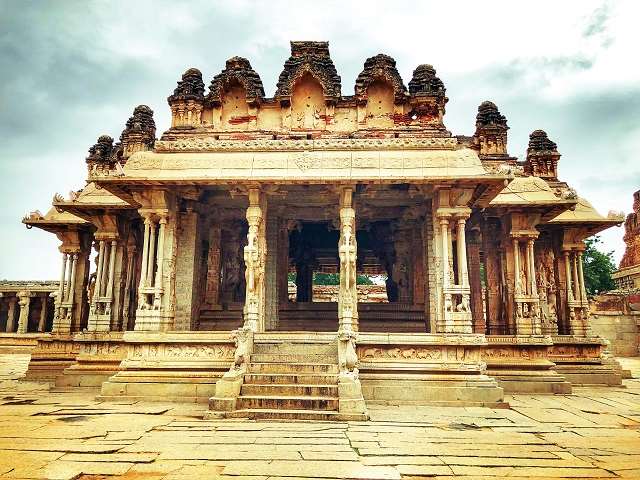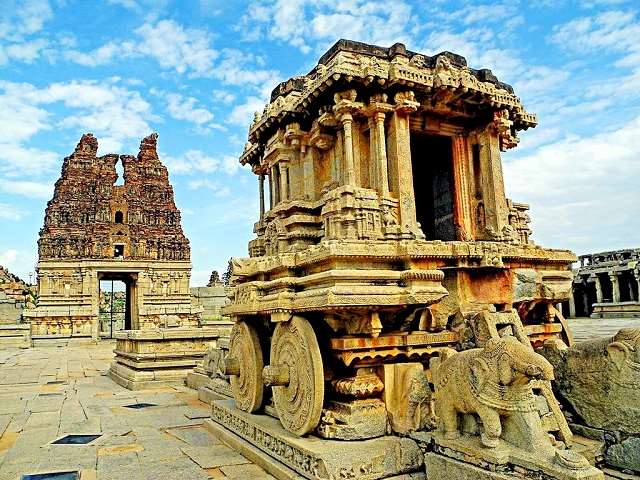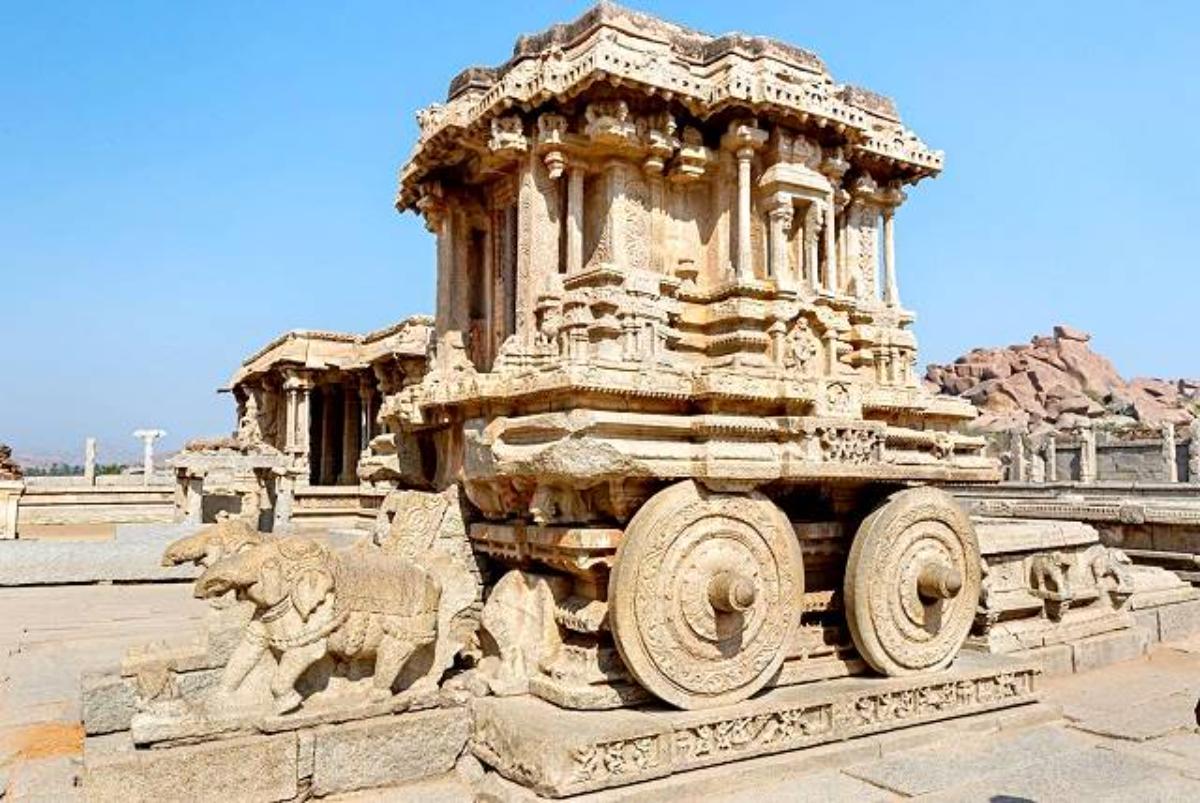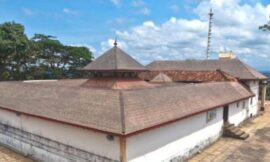The Vittala Temple or Shri Vijaya Vittala Temple is dedicated to Lord Vittala, an incarnation of Lord Vishnu. An idol of Vittala-Vishnu was enshrined in the temple. The Vittala Temple is presumed to be the grandest of all temples and monuments in Hampi. The temple exemplifies the immense creativity and architectural excellence possessed by the sculptors and artisans of the Vijayanagara area.

Page Contents
Architecture:
The Vittala Temple is presumed to be the grandest of all temples and monuments in Hampi. The temple exemplifies the immense creativity and architectural excellence possessed by the sculptors and artisans of the Vijayanagara era. The Vittala temple is built in the Dravidian style of architecture. It has traits and features that are characteristic of typical south Indian temple architecture. It’s elaborate and artistic carvings and magnificent architecture is unmatched by any other structure found in Hampi.

It is believed that the main shrine of the temple originally had one enclosed Mantapa. An open Mantapa was added to it in the year 1554 A.D. The temple complex is a sprawling area that is surrounded by high compound walls and three towering gateways. The temple complex has many halls, shrines and pavilions located inside it. Each of these structures is made of stone and each structure is a beauty in itself.
Notable among these structures are the shrine of the Goddess (also known as Devi shrine), Maha Mantapa or main hall (also known as Sabha Mantapa or congregation hall), Ranga Mantapa, Kalyana Mantapa (marriage hall), Utsava Mantapa (festival hall), and the famous Stone Chariot.
Main Attractions of Vittala Temple:
The Vittala Temple is regarded as the most ornate of the Vijayanagara temples. The temple comprises of several attractions that makes it a must-visit structure for tourists. In fact it is the most visited monument in Hampi and as such, it is also the most photographed monument in Hampi.
Among the main attractions of the Vittala Temple are:
Maha Mantapa:
The Maha Mantapa, situated in the inner courtyard of the temple complex is a beauty decorated with carvings of warriors, horses, swans and several other ornamental designs. The intricately decorated pillars have beautiful sculptures of Narasimha and Yali. he Maha Mantapa comprises of four smaller halls. The steps on the eastern side of the Maha Mantapa are decorated with elephant balustrade. There are forty pillars lining the facade of the temple. Each of these pillars has a height of 10 feet.
The central part of the Maha Mantapa has sixteen intricately decorated pillars having beautiful sculptures of Narasimha and Yali. These set of sixteen pillars forms a rectangular court. The ceiling of the Maha Mantapa is a richly designed structure. The beautifully sculpted ornate pillars of the Maha Mantapa exemplify the splendour of this magnificent temple.
Ranga Mantapa:
The Ranga Mantapa is renowned for its 56 musical pillars. These pillars are also known as SAREGAMA pillars, denoting the musical notes emanated by them. The musical notes are produced when the pillars are tapped gently. Every main pillar is surrounded by 7 minor pillars. These 7 pillars give off 7 different musical notes from the representative musical instruments. The notes vary in sound quality depending on the instrument. The cluster of musical pillars were carved out of huge single pieces of resonant stone. The emission of musical notes from stone pillars was a mystery that fascinated many people down the centuries. To unravel the mystery, Britishers in the colonial era cut two pillars. Till date the ruins remain and the mystery remains unsolved.

Stone Chariot:
The Vittala Temple Complex has the richly sculpted Stone Chariot, which is considered to be the most stunning architecture of the Vijayanagara kingdom. The Stone Chariot or Ratha stands in the courtyard of temple. It is one of the three famous stone chariots in India. The other two chariots are situated in Konark (Odissa) and Mahabalipuram (Tamil Nadu).
This is located inside the Vittala Temple campus. You would be visiting the Stone Chariot as part of your Vittala Temple tour. In mythology Lord Vittala is an aspect of Lord Vishnu (See Gods of Hampi and Mythology of Hampi). Garuda (lord of eagles) is the vehicle (mount) of Lord Vishnu. The Stone Chariot once contained the icon on Garuda, though the shrine is empty now. This shrine is on the axis of the massive Vittala Temple and faces the sanctum of Vittala Temple.

It may appear to you (and sometimes even referred to) as a monolithic structure. In reality this stone shrine was built with many giant granite blocks. The joints are smartly hidden in the carvings and other decorative features that adorn the Stone Chariot.
The chariot is built on a rectangular platform of a feet or so high. All around this base platform is carved with mythical battle scenes. Though the chariot is not resting on it, the four giant wheels attached mimic the real life ones complete with the axis shafts and even the brakes. A series of concentric floral motifs decorate the wheels. It appears from the marks on the platform, where the wheels rest, the wheels were free to move around the axis.
You can still see the remains of the painting on the carvings of the chariot. Probably because it was relatively protected from the natural weather elements, the undercarriage of the chariot spots one of the best preserved specimens of this kind of paintings. It is believed the whole of the Vittala Temple’s sculptures were once beautifully painted in similar fashion using the minerals as medium.
In front of the chariot two elephants are positioned as if they are pulling the chariot. In fact these stone elephants were brought from elsewhere and positioned here at a later stage. Originally two horses were carved in that position. The tails and the rear legs of the horses can be still seen just behind these elephant sculptures. A broken stone ladder once gave access to the sanctum is kept between the elephants. You can still spot the marks on the floor and the doorsill where once the ladder stood.
There was even a dome like superstructure over the chariot. That too is missing now. However you can see them on the first ever photographs of Hampi taken in 1856 by Alexander Greenlaw.
Vittala Temple and the Stone Chariot inside are must do things in your Hampi itinerary. And also don’t miss that customary photo opportunity with the stone chariot as your background!
History:
The renowned Vittala Temple dates back to the 15th century. It was built during the reign of King Devaraya II (1422 – 1446 A.D.), one of the rulers of the Vijayanagara Empire. Several portions of the temple were expanded and enhanced during the reign of Krishnadevaraya (1509 – 1529 A.D.), the most famous ruler of the Vijayanagara dynasty. He played a significant role in giving the monument its present look.
Timings:
8:30 AM to 5:00 PM on all days of the week.
How to Reach:
The Vittala Temple in Hampi is situated at the end of the ruined Vittala Bazaar. The place can be easily reached by vehicles from all parts of Hampi.
By Air:
Hampi cannot be reached directly by flight as the ruined town has no airport of its own. Ballari (Bellary) is the closest town to have an airport. Ballary is situated at a distance of around 64 km from Hampi. Visitors can reach Ballari by taking a flight and then proceed to Hampi by means of local transport.
By Rail:
Hampi does not have a railway station. The nearest railway station can be found in the city of Hosapete (Hospet). The Hospet Junction Railway Station is connected to several other towns and cities of Karnataka by means of regular trains. Hosapete is situated at a distance of around 10 km from Hampi.
One of the easiest ways to reach Hampi from Hosapete is to board a bus. There are a few other means of local transport also to reach Hampi from Hosapete.
By Road:
Hampi has a good road network and is connected to many towns and cities in Karnataka by this network. There are a lot of government and private buses that travel between Hampi and several towns and cities in the state.


